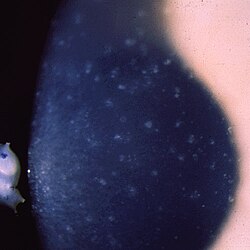Meesmann corneal dystrophy
Editor-In-Chief: Prab R Tumpati, MD
Obesity, Sleep & Internal medicine
Founder, WikiMD Wellnesspedia &
W8MD medical weight loss NYC and sleep center NYC
| Meesmann corneal dystrophy | |
|---|---|

| |
| Synonyms | Meesmann epithelial corneal dystrophy, Meesmann dystrophy |
| Pronounce | N/A |
| Specialty | N/A |
| Symptoms | Corneal epithelium microcysts, vision disturbances |
| Complications | Corneal erosion, photophobia |
| Onset | Early childhood |
| Duration | Lifelong |
| Types | N/A |
| Causes | Mutations in KRT3 or KRT12 genes |
| Risks | Genetic predisposition |
| Diagnosis | Slit-lamp examination, genetic testing |
| Differential diagnosis | Other corneal dystrophies |
| Prevention | N/A |
| Treatment | Lubricating eye drops, contact lenses, keratoplasty |
| Medication | N/A |
| Prognosis | Generally good with management |
| Frequency | Rare |
| Deaths | None directly attributable |
Meesmann corneal dystrophy (ICD-10: H18.5) is a rare form of corneal dystrophy, a group of genetic, often progressive, eye disorders characterized by the accumulation of abnormal material in the cornea. The cornea is the clear, dome-shaped surface that covers the front of the eye. Meesmann corneal dystrophy is caused by mutations in the KRT3 or KRT12 gene. These genes provide instructions for making proteins that are part of intermediate filaments, tough, resilient fibers that provide support and strength to cells. The KRT3 and KRT12 genes are specifically involved in the production of keratins, a type of intermediate filament protein, in corneal epithelial cells. Mutations in these genes alter the structure and function of these proteins, leading to the formation of abnormal, blister-like lesions in the cornea. Symptoms of Meesmann corneal dystrophy typically appear in early childhood and may include photophobia (light sensitivity), a gritty sensation in the eyes, and mild visual impairment. However, many affected individuals are asymptomatic and the condition is often discovered during a routine eye examination. Treatment for Meesmann corneal dystrophy is typically supportive and may include the use of lubricating eye drops or ointments to relieve discomfort. In severe cases, a corneal transplant may be necessary.
See also
References
External links
- Genetics Home Reference: Meesmann corneal dystrophy
- National Organization for Rare Disorders: Meesmann corneal dystrophy
| Eye diseases and disorders | ||||||||||
|---|---|---|---|---|---|---|---|---|---|---|
This eye diseases related article is a stub.
|
| Genetic disorders relating to deficiencies of transcription factor or coregulators | ||||||||||||||||||||||||||||||||||
|---|---|---|---|---|---|---|---|---|---|---|---|---|---|---|---|---|---|---|---|---|---|---|---|---|---|---|---|---|---|---|---|---|---|---|
|
NIH genetic and rare disease info
Meesmann corneal dystrophy is a rare disease.
| Rare and genetic diseases | ||||||
|---|---|---|---|---|---|---|
|
Rare diseases - Meesmann corneal dystrophy
|
Transform your life with W8MD's budget GLP-1 injections from $125.
W8MD offers a medical weight loss program to lose weight in Philadelphia. Our physician-supervised medical weight loss provides:
- Most insurances accepted or discounted self-pay rates. We will obtain insurance prior authorizations if needed.
- Generic GLP1 weight loss injections from $125 for the starting dose.
- Also offer prescription weight loss medications including Phentermine, Qsymia, Diethylpropion, Contrave etc.
NYC weight loss doctor appointments
Start your NYC weight loss journey today at our NYC medical weight loss and Philadelphia medical weight loss clinics.
- Call 718-946-5500 to lose weight in NYC or for medical weight loss in Philadelphia 215-676-2334.
- Tags:NYC medical weight loss, Philadelphia lose weight Zepbound NYC, Budget GLP1 weight loss injections, Wegovy Philadelphia, Wegovy NYC, Philadelphia medical weight loss, Brookly weight loss and Wegovy NYC
|
WikiMD's Wellness Encyclopedia |
| Let Food Be Thy Medicine Medicine Thy Food - Hippocrates |
Medical Disclaimer: WikiMD is not a substitute for professional medical advice. The information on WikiMD is provided as an information resource only, may be incorrect, outdated or misleading, and is not to be used or relied on for any diagnostic or treatment purposes. Please consult your health care provider before making any healthcare decisions or for guidance about a specific medical condition. WikiMD expressly disclaims responsibility, and shall have no liability, for any damages, loss, injury, or liability whatsoever suffered as a result of your reliance on the information contained in this site. By visiting this site you agree to the foregoing terms and conditions, which may from time to time be changed or supplemented by WikiMD. If you do not agree to the foregoing terms and conditions, you should not enter or use this site. See full disclaimer.
Credits:Most images are courtesy of Wikimedia commons, and templates, categories Wikipedia, licensed under CC BY SA or similar.
Contributors: Prab R. Tumpati, MD


